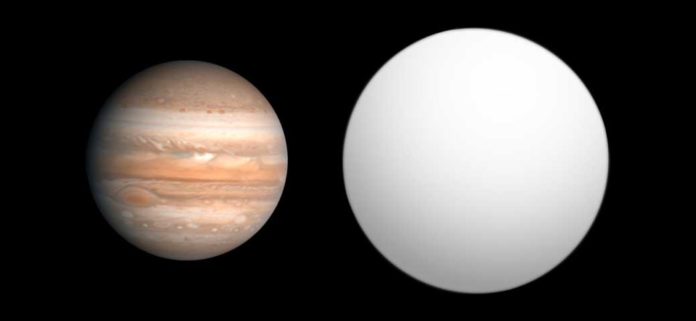Astronomers at the Caltech have obtained some of the best and the more robust data yet on the composition of a planet known as HR 8799 c. While different scientists had previously made comparative estimations of this planet, but these new data show the power of combining high-resolution spectroscopy with a system known as adaptive optics, which redresses for the obscuring impact of Earth‘s atmosphere.
HR 8799 c is an extrasolar planet located approximately 129 light-years away in the constellation of Pegasus, orbiting the 6th magnitude Lambda Boötis star HR 8799. This planet has a mass between 5 and 10 Jupiter masses and a radius from 20 to 30% larger than Jupiter’s.
Dimitri Mawet, an associate professor of astronomy at Caltech said, “This type of technology is exactly what we want to use in the future to look for signs of life on an Earth-like planet. We aren’t there yet, but we are marching ahead.
Taking pictures of planets that circle different stars—exoplanets—is an impressive undertaking. Light from the host stars far surpasses the planets, making them difficult to see. In excess of dozens of exoplanets have been straightforwardly imaged up until this point, including HR 8799 c and three of its planetary allies.
Truth be told, HR 8799 is the only multiple- planet system to have its image taken. When a picture is obtained, astronomers can utilize instruments, called spectrometers, to break separated the planet’s light, similar to a prism transforming sunlight into a rainbow, consequently uncovering the fingerprints of chemicals. Up until now, this methodology has been utilized to find out about the environments of several giant exoplanets.
Now, by perfecting their technique using Keck, scientists want to learn about the compositions and dynamics of giant planets.
Lead author is Ji Wang said, “Right now, with Keck, we can already learn about the physics and dynamics of these giant exotic planets, which are nothing like our own solar system planets.”
For the study, astronomers used an instrument on Keck called NIRSPEC (near-infrared cryogenic echelle spectrograph), a high-resolution spectrometer that works in infrared light. They coupled the instrument with adaptive optics, a method for creating crisper pictures using a guide star in the sky as a means to measure and correct the blurring turbulence of Earth’s atmosphere.
This is for the first time, astronomers used this technique to directly image planets using what is known as the L-band, a type of infrared light with a wavelength of around 3.5 micrometers. This region of the electromagnetic spectrum contains many detailed chemical fingerprints.
The researchers say that the addition of adaptive optics made the L-band more accessible for the study of the planet HR 8799 c. In their study, they made the most precise measurements yet of the atmospheric constituents of the planet, confirming it has water and lacks methane as previously thought.
Wang said, “We are now more certain about the lack of methane in this planet. This may be due to mixing in the planet’s atmosphere. The methane, which we would expect to be there on the surface, could be diluted if the process of convection is bringing up deeper layers of the planet that don’t have methane.”
Mawet’s team is now gearing up to turn on their newest instrument at Keck, called the Keck Planet Imager and Characterizer (KPIC). The team will also use adaptive optics-aided high-resolution spectroscopy that can see planets that are fainter than HR 8799 c and closer to their stars.
Astronomers published their study in the Astronomical Journal.
